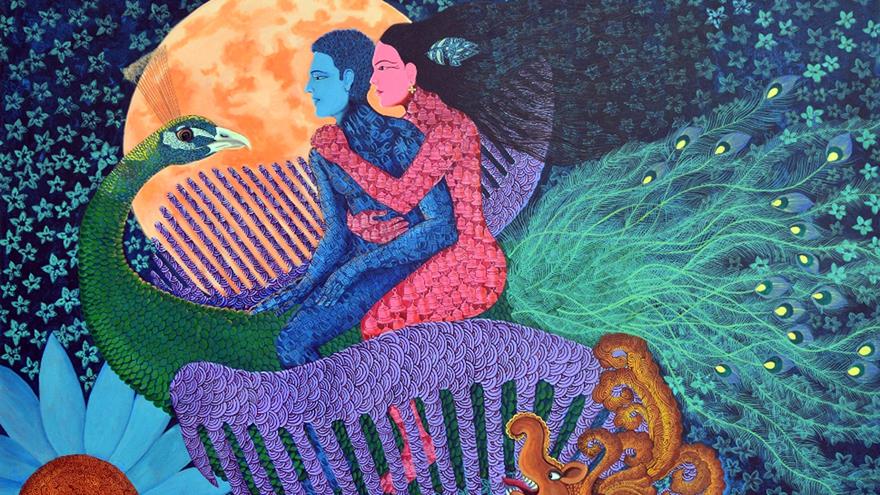The First Exhibition of Contemporary Nepali Artists in the U.S. Debuts in Drexel’s Pearlstein Gallery
 By Emily Storz
By Emily Storz

- Former U.S. Attorney for the Southern District of New York, Partner at WilmerHale Preet Bharara Will Address Drexel Kline School of Law Graduates at Commencement
- Drexel Extends 50% Tuition Offer to All Community College Graduates
- Virtual Reality May Enhance Learning
- Drexel Researchers Selected for Federal AI Research Pilot Program

The Leonard Pearlstein Gallery of Drexel University’s Antoinette Westphal College of Media Arts & Design will present “NEPAL: Contemporary Paintings and Early Photographs in the collection of Dr. David Nalin” on Thursday, Jan. 18 with an opening reception from 5-7:30 p.m. The exhibition will bring together more than 40 contemporary paintings and over 40 historical photos from the Nalin collection.
Forty-one paintings by 13 contemporary Nepali artists will be on display alongside 42 early photographs from late 19th- and early 20th-century Nepal. This is the first exhibition of contemporary Nepali artists in the United States.
The exhibition will run from Thursday, Jan. 18 through Tuesday, March 19. Operating hours are Tuesday through Friday from 12 p.m. - 6 p.m. and Saturday 12 p.m. - 5 p.m. in the URBN Annex (3401 Filbert St.).
The inaugural showcase in the U.S. of Nalin’s collection is exclusively devoted to the current art scene from the “Roof of the World.” Featured Nepali artists Sabin Acharya, Sabita Dangol, Ajaya Deshar, Krishna Lama, Roshan Pradhan, Rajan Pant, Ishan Pariyar, Jasmie Rajbhandari, Uddab Raj Rimal, Shiva Kumar Sharma, Prithvi Shrestha and Erina Tamrakar, together are gaining considerable international acclaim for their style.
A distinctive feature of their practice is the seamless integration of traditional elements with modern aesthetics. They often draw inspiration from the cultural heritage, folklore and religious iconography of Nepal and broader South Asia, while employing contemporary techniques and conceptual frameworks. Themes of individual and cultural identity, gender equality, conflicts and crises, and the interplay between tradition and modernity resonate strongly in the images being displayed.
“The artists grapple with questions of belonging, the impact of globalization, and the preservation of cultural heritage in the face of rapid change,” said Pia Brancaccio, PhD, an art history professor in the Antoinette Westphal College of Media Arts & Design. “They articulate narratives that bridge the traditional and the modern, the local and the global.”
According to Brancaccio, the early Nepali photographs in the Nalin collection complement the works by contemporary artists by offering a vantage point into the formation of a “modern” visual language in Nepal. They hold unique historical significance and capture a transformative period in the country's history. The advent of photography in Nepal can be traced back to the mid-19th century when the medium was still in its infancy. European and Indian photographers were active in Nepal during the Rana period (1846–1951) and produced images that offer a glimpse into the architecture, landscape, and lifestyle of the Nepali and colonial elites of the time. The early photographers used the wet plate collodion process, which involved glass plates coated with a light-sensitive chemical. Two original photo glass plates will be on display in the exhibition.
Dr. David Nalin (an Art Collector and a Physician) began collecting Asian art in 1967-70 while on assignment to former East Pakistan, now Bangladesh, for the U.S. National Institutes of Health. His scientific work in South Asia lasted for 12 years, during which time he had the opportunity to visit Nepal many times where he became familiar with traditional and modern Nepali culture and met several contemporary artists whose works are represented in this exhibition.
A day-long symposium dedicated to the exhibition themes will take place in the gallery on Saturday, Feb. 24 in morning and afternoon sessions. Speakers will include Ajay Sinha, PhD, professor of Art History at Mount Holyoke College, Kerry Brown, PhD, professor of Art History at Savannah College of Arts and Design and Gautam Vajracharya, PhD, scholar of Nepali art. A roundtable with the artists will conclude the day. The symposium is open to the public with reservations.
Drexel News is produced by
University Marketing and Communications.
